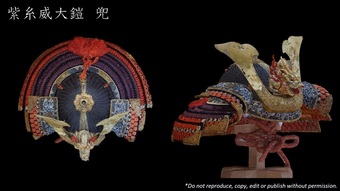ARC-iJAC Project Spotlights: Interview with Akihiro Tsukamoto (Associate Professor, Tokushima University) on the Construction of a 3D Model Database of Japanese Armor in the Collection of the Tokushima Castle Museum
We discovered that the Tokushima Castle Museum was frequently exhibiting some popular, historic pieces of armor. So, we had the idea to turn them into 3D images so that visitors could see them from any perspective by freely rotating them on a PC screen or mobile device.
After discussing the idea with the curator in charge and the museum director, this project was born.
How do you feel about the overall execution of this project? Have you come across any particular challenges?
Prof. Tsukamoto: With digital images, results can be previewed and checked immediately. To generate point cloud data, however, as in this project, several hundred photographs of a single part of the armor have been taken and analyzed with SfM software. So, the overall process is quite time-consuming.
But sometimes, despite all the time spent, we could not generate the 3D data nicely. Perhaps the most worrisome part of this project is that we do not know the results until we run the data through analysis. Even if we secure a large room for shooting and take hundreds of shots for one part of the armor, the data generated may still result in failure. And it is even more difficult to request a re-shoot as we are dealing with valuable materials.
To further develop such 3D archives, it will be essential to maintain the know-how and manuals for such photography. For this reason, we consider it necessary to accumulate and share know-how through case studies such as this project.
Could you please describe how the ARC-iJAC resources have supported you in realizing this project?
Prof. Tsukamoto: The know-how that Prof. Tanaka and Prof. Hasegawa have accumulated at the ARC-iJAC so far to visualize 3D models effectively has been greatly useful.
Since armor consists of many refined ornaments and various textures, their technical know-how and equipment at the CG Laboratory were very helpful to us.
As with the 3D digital archiving system of netsuke from the British Museum's collection that was constructed using the ARC's Model of Digital Archiving, we plan to utilize the same kind of system to build an armor database.
Could you please give us an overview of your research outcomes within the last fiscal year?
Prof. Tsukamoto: With the accumulation of our measurement know-how throughout the last fiscal year, we have also improved the quality of the visualized images and 3D point cloud data obtained.
The armor in this project is comprised of various materials, from shiny metal and lacquer to fibers such as fur and cloth. To capture them well, we made several subtle adjustments to the lighting, polarizing filters, and shooting angles.
In the future, we would like to continue our trial-and-error process to generate higher-quality 3D data and compile the results of our know-how.
Are there any plans for the future to continue this research project?
Prof. Tsukamoto: We plan to continue this joint research by presenting our achievements while accumulating know-how in 3D digital archiving. For example, we would like to include other cultural properties and armors from different regions.
The more 3D digital archives we construct, the more we can compare and identify differences in regional features. Furthermore, through accumulating data on the automatic extraction of the features of cultural properties via machine learning, we will eventually be able to identify the type and age of objects automatically.
We have received inquiries from other municipalities to implement a 3D digital archive. Assuming that such initiatives will increase in the future, we would like to develop a manual that will allow us to do some of the photographic work mechanically and further automate the process.


